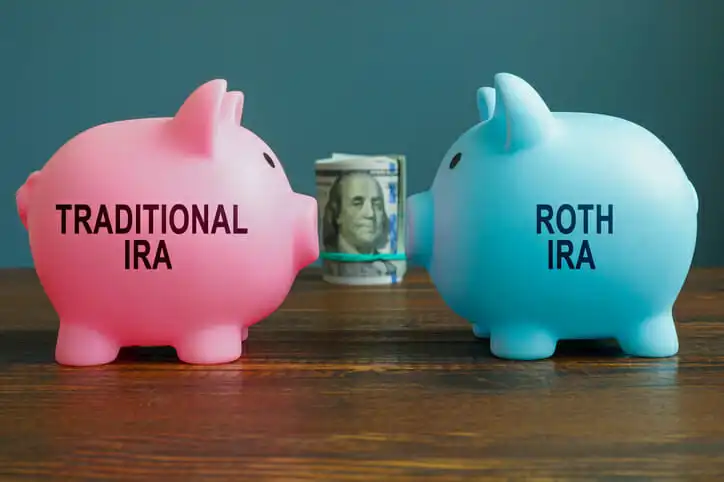An individual retirement account (IRA) gives you a tax-advantaged way to save for retirement. Several different types of IRAs accounts exist. Most let savers deduct contributions from their current taxable income and also delay taxing earnings until withdraw money later on in retirement. Another type taxes contributions but allows withdrawals to be taken tax-free. We’ll discuss the various types of IRAs and how they can be beneficial to you.
A financial advisor can help you decide which type of IRA is a good fit for you.
IRA Basics
IRAs came into existence with the Employee Retirement Income Security Act (ERISA) in 1975. This law encouraged American workers to financially prepare for their own retirement by giving them tax-advantaged ways to save with IRAs.
Since then, IRA rules and regulations have changed and new IRA types have been created. However, all conform to the same basic idea. By providing tax incentives to save, they will help people enjoy financially secure lives after they stop working for a living.
IRA Types
Here are the types of IRAs and their main distinguishing features:
Traditional IRA
A traditional IRA lets you make tax-deductible contributions that can reduce your current taxable income. You can invest money in the account in mutual funds or other investments you select. Earnings also grow tax-free. Taxes on contributions and earnings aren’t due until you withdraw the money.
There are limits to how much you can contribute to a Traditional IRA. For 2026, the maximum for most workers is $7,500. If you are 50 or older, you are allowed a catch-up contribution of another $1,100. In some situations, such as having a spouse covered by a workplace retirement plan, contributions may not be fully tax deductible.
There are also limits on how long you leave money untaxed in the Traditional IRA. Starting at age 73, you have to take annual required minimum distributions (RMDs) and pay taxes at your regular rate.
Another rule restricts you from taking withdrawals in most cases before age 59 ½ without incurring penalties. The penalty for early withdrawals is 10% of the amount plus any taxes owed. The IRS permits early hardship withdrawals without penalty in certain circumstances.
You can set up an IRA at many banks, brokerages and other financial institutions. Employers can also set up IRAs for their employees, who can elect to have part of their paychecks diverted to the IRA.
SEP IRA

A simplified employee pension IRA (SEP-IRA) lets small business owners and self-employed people accumulate tax-advantaged retirement savings for themselves and their employees. SEP-IRA withdrawal rules work similarly to Traditional IRAs, but the contribution limits are different.
With a SEP-IRA, you can contribute up to 25% of an employee’s pay or $72,000, whichever is less, in 2025. There are no catch-up contributions to SEP-IRAs.
SIMPLE IRA
The savings incentive match plan for employees (SIMPLE IRA) is designed for owners and employees of small businesses with fewer than 100 employees. It allows for higher contribution limits than a Traditional IRA and also allows employer matches. Otherwise, it operates similarly to other IRAs with regards to withdrawals.
With a SIMPLE IRA, an employee can elect to defer some of their salary by directing it to the retirement account. The employer can match up to 3% of employee contributions. For 2026, the SIMPLE IRA contribution limit is $17,000. Catch-up contributions of another $4,000 are also permitted.
Roth IRA
The Roth IRA stands the IRA strategy on its head by funding retirement accounts with after-tax dollars. Roth contributions don’t give you current-year tax deductions, but earnings grow tax-free. Earnings and contributions can be withdrawn after age 59 ½ without owing income taxes as long as the account has been in existence at least five years.
Roth IRAs may let savers who expect to be in higher tax brackets after retirement save on overall taxes. They are also free of RMDs, so funds can be left in the account to grow tax-free indefinitely.
Roth IRAs are designed for lower- and moderate-income savers and an income cap limits higher earners’ use of Roths. For the 2026 tax year, single taxpayers and married taxpayers filing separately with an adjusted gross income of $153,000 or more cannot contribute the maximum Roth amount of $7,500 per year. Allowed contributions decrease until, at $168,000 income, no Roth contributions are allowed. A backdoor Roth is a way for higher-income taxpayers to convert a regular IRA to a Roth account.
Bottom Line

Since the traditional IRA emerged in 1975, several different types of IRAs have come on the scene. Traditional IRAs are widely used by individuals, including those with and without employer-sponsored retirement plans. SEP-IRAs and SIMPLE IRAs take different approaches to giving self-employed and small business owners and their employees access to tax-advantaged retirement savings accounts. Roth IRAs lack current tax deduction opportunities but allow for tax-free withdrawals later on.
Retirement Tips
- Consider talking to a financial advisor about how you’ll save for retirement. SmartAsset’s free tool matches you with vetted financial advisors in your area, and you can interview your advisor matches at no cost to decide which one is right for you. If you’re ready to find an advisor who can help you achieve your financial goals, get started now.
- SmartAsset’s Retirement Calculator can help you decide how much to save for your retirement. Simply provide some details about your situation, such as your age, location, income, existing savings and planned retirement age. The calculator will estimate your annual retirement expenses and recommend a monthly savings figure.
Photo credit: ©iStock.com/Maks_Lab, ©iStock.com/designer491, ©iStock.com/SrdjanPav
